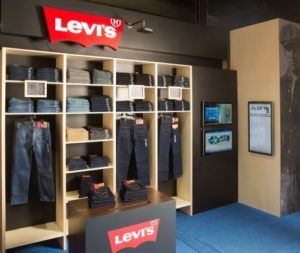LEVI’S & INTEL – RFID PILOT AT LEVI’S

Intel team members designed and implemented radio-frequency identification (RFID) tags, in-store sensors, a gateway system, and cloud-based analytics into an extensible open-source platform in order to deliver near-real time inventory monitoring.
“By improving the accuracy of our inventory system, we can help our salespeople provide the right answer, right away.” – Noah Treshnell, Senior Vice President, Americas, Levi Strauss & Co
Since making the first pair of blue jeans in 1873, Levi Strauss & Co. has grown to become one of the world’s largest clothing companies and a global leader in jeans. Today, Levi’s continuously aims to improve the in-store experience by making sure customers and salespeople can find the products they need, when they need them. Working with Intel data scientists, the company launched a proof of concept to explore ways the Trusted Analytics Platform (TAP) can help salespeople quickly find misplaced items in a store so they can place items back in the right spots on the shelve, and ready for customers. [i]Using radio-frequency identification tags (RFID) on all items in the store, Intel gateways, sensors, and cloud-based analytics, the sales team gains a better understanding of what’s on the shelf or what might be running low. This is making the process of inventory management more effective. Practically, all this means is that when the consumer comes into the store looking for a perfectly fitting pair of jeans in a specific size and color, it’s on the shelf, and the store associates can spend more time delivering a great shopping experience to the consumer and less time checking the back for sizes.[ii]
TAP Technology
- Clothing items are equipped with small, inexpensive RFID tags. The Intel team installed antenna sensors in the ceiling of the store that enable continuous, real-time monitoring of the location of the RFID tags. A gateway collects data from the sensors and then sends a smaller set of data to the cloud for detailed analysis.
- The gateway system conducts some basic data analysis to reduce the amount of data transmitted over the network to the cloud. It sends only data coming from misplaced items or with changes in location.
- Trusted Analytics Platform (TAP) is an open source platform initially developed by Intel. TAP algorithms enables Levi’s team members to discover whether items are misplaced.
- The algorithms use data collected overnight to determine the correct locations.
- During store hours, as sensors monitor the location of items, the algorithms determine whether an item is located in the correct location for its group. If a pair of jeans is misplaced or left in a fitting room, the algorithm could generate an alert on a mobile app. For example, a store might decide that moving a shirt back to its proper rack can wait until the end of the day, whereas moving the last pair of jeans in a particular size is an immediate priority.[iii]
Value Creation
- Greater customer satisfaction
Deliver customized superior customer service - Fewer missed sales
Avoid lost sales opportunities when customers can’t find what they need - Enhanced efficiency
Reduce time and effort to find misplaced items, optimize personnel resources - Inventory accuracy
Quantify stock levels, request appropriate replacement products, avoid out-of-stock situations, optimize physical store and stock space
Future Application
In the future, stores could use this solution to help generate new customer insights—similar to those that have been available through online transactions. It is especially useful in determining which combinations of items customers are trying on, and which combinations are frequently purchased together. As a result, Levis and other brands, can optimize marketing, promotions and display. Overall brands can deliver a targeted experience in physical stores similar to online commerce.[iv]
Lessons Learned
In many cases, organizations can draw on existing algorithms to quickly apply advanced analytical informed solutions. Collaborating with experienced data scientists can help organizations shape analytics to specific business cases and so maximize the value of the analytical ecosystem.
[i] https://www.intel.com/content/dam/www/public/us/en/documents/case-studies/enhancing-in-store-retail-experience-study.pdf
[ii] http://www.levistrauss.com/unzipped-blog/2015/09/lsco-intel-rfid-pilot-at-levis-plaza/
[iii] https://www.intel.com/content/dam/www/public/us/en/documents/case-studies/enhancing-in-store-retail-experience-study.pdf
[iv] https://www.intel.com/content/dam/www/public/us/en/documents/case-studies/enhancing-in-store-retail-experience-study.pdf




